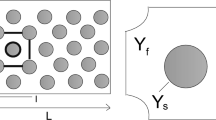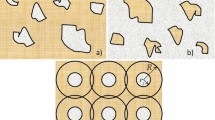Abstract
A model of flow through a porous medium with phase transitions which permits an efficient qualitative investigation is proposed for two fluids with sharply different (high-contrast) mobilities. It is shown that the model problem of flow toward a unit sink is singularly perturbed and can be solved using analytic asymptotic matching methods. The nature of the singularity is associated with violation of the condition of the flow contrast in certain zones. The solution can be unstable depending on the direction of interphase mass transfer and the zone in which the process takes place.
Similar content being viewed by others
References
M. B. Panfilov, "Asymptotics of the solution of problems of the flow of a multicomponent mixture with a boundary layer through a porous medium,"Izv. Akad. Nauk SSSR, Mekh. Zhidk. Gaza, No. 4, 94 (1985).
M. B. Panfilov, "Asymptotic methods of solution of problems of the flow of multicomponent mixtures gas-condensate deposit depletion processes," in:Dynamics of Multiphase Media [in Russian], Nauka, Novosibirsk (1985), P. 183.
M. B. Panfilov, "Matching of asymptotic expansions in problems of the flow of a gas-condensate mixture through a porous medium,"Inzh. Fiz. Zh.,45, 608 (1983).
L. I. Sedov,Continuum Mechanics, Vol. 1 [in Russian], Nauka, Moscow (1976).
V. N. Nikolaevskii, E. A. Bondarev, M. I. Mirkin et al.,Movement of a Hydrocarbon Mixture through a Porous Medium [in Russian], Nedra, Moscow (1968).
P. I. Nigmatulin,Dynamics of Multiphase Media, Vol. 2 [in Russian], Nauka, Moscow (1987).
A. M. Il’in,Matching of Asymptotic Expansions of Solutions of Boundary Value Problems [in Russian], Nauka, Moscow (1989).
S. A. Lomov,Introduction to the General Theory of Singular Perturbations [in Russian], Nauka, Moscow (1981).
M. D. Van Dyke,Perturbation Methods in Fluid Mechanics, Academic Press, New York (1964).
W. Wasow,Asymptotic Expansions for Ordinary Differential Equations, N.Y., etc., Wiley (1965).
A. B. Vasil’eva and V. F. Butuzov,Asymptotic Expansions of Solutions of Singularly Perturbed Equations [in Russian], Nauka, Moscow (1973).
A. N. Tikhonov, A. B. Vasil’eva, and A. G. Sveshnikov,Differential Equations [in Russian], Nauka, Moscow (1980).
B. E. Somov, "Methods of solving problems of heterogeneous flow of multicomponent mixtures through a porous medium," in:Field Development and Operation {cm[in Russian]},Proceedings of MINKh i GP, No. 174, Moscow (1983), P. 55.
V. S. Mitlin, "Two-phase multicomponent filtration: instabilities, autowaves and retrograde phenomena,"J. Fluid Mech.,220, 369 (1990).
Additional information
Moscow. Translated from Izvestiya Rossiiskoi Akademii Nauk, Mekhanika Zhidkosti i Gaza, No. 2, pp. 124–135, March–April, 2000.
The work was carried out with support from the European Foundation INTAS (grant No. 94-4367) and the Russian Foundation for Basic Research (project No. 95-01-01179a).
Rights and permissions
About this article
Cite this article
Panfilov, M.B., Shilovich, N.N. Flow of fluids with substantially different mobilities through a porous medium in the presence of phase transitions: Boundary layer phenomena, spatial phase structures, and instability of the flow. Fluid Dyn 35, 258–267 (2000). https://doi.org/10.1007/BF02831434
Received:
Issue Date:
DOI: https://doi.org/10.1007/BF02831434




